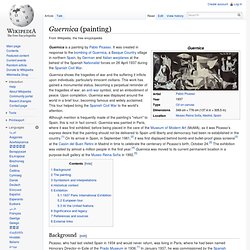

T.J. Clark on Guernica. Two great minds, Picasso and T.J.

Clark matched in a lecture. At first I was dubious, when the first statement Professor Clark made was "Space was the form truth took for him as a painter. " This seemed unduly formal, detached. A major exhibition on the Spanish Civil War. "Dreams and Nightmares"—at the Imperial War Museum, London, until April 28, 2002 By Vicky Short 3 January 2002 The Spanish Civil War, which began in 1936, inspired a generation of workers, artists and intellectuals.

The struggle to defend republican Spain against the fascist phalange headed by General Francisco Franco drew to its banner the most self-sacrificing representatives of that generation. Guernica (painting) Guernica shows the tragedies of war and the suffering it inflicts upon individuals, particularly innocent civilians.

This work has gained a monumental status, becoming a perpetual reminder of the tragedies of war, an anti-war symbol, and an embodiment of peace. Upon completion, Guernica was displayed around the world in a brief tour, becoming famous and widely acclaimed. This tour helped bring the Spanish Civil War to the world's attention. Although mention is frequently made of the painting's "return" to Spain, this is not in fact correct. Picasso, who had last visited Spain in 1934 and would never return, was living in Paris, where he had been named Honorary Director-in-Exile of the Prado Museum in 1936.[1] In January 1937, he was commissioned by the Spanish Republican government to create a large mural for the Spanish display at the Exposition Internationale des Arts et Techniques dans la Vie Moderne at the 1937 World's Fair in Paris.